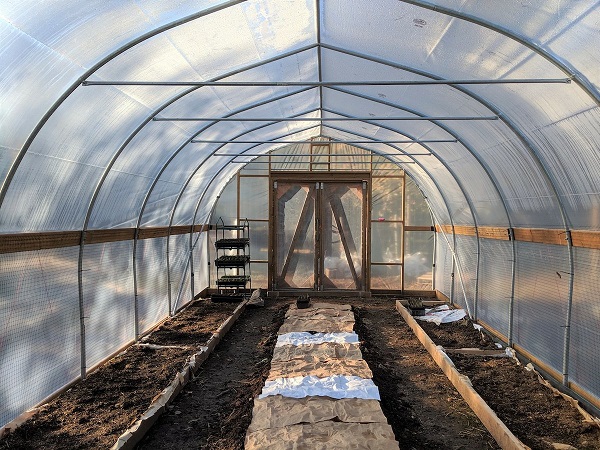A tunnel greenhouse, also known as a hoop house or polytunnel, is a type of greenhouse structure that is designed to extend the growing season and protect plants from adverse weather conditions. It consists of a series of curved or arched hoops made of metal or plastic that are covered with a layer of greenhouse-grade plastic film or specialized greenhouse fabrics.

The hoops are usually anchored to the ground and spaced several feet apart, creating a tunnel-like structure. The covering material is stretched over the hoops and secured to the ground or to a baseboard, creating a sealed environment. The plastic film or fabric allows sunlight to penetrate while trapping heat inside, creating a warm and protected space for plants to grow.
Tunnel greenhouses are typically less expensive and easier to construct compared to traditional glass or rigid-walled greenhouses. They are commonly used by small-scale farmers, gardeners, and horticulturists to extend the growing season, protect plants from frost, wind, and excessive rain, and provide a controlled environment for cultivation.
The temperature and humidity inside a tunnel greenhouse can be regulated to some extent through ventilation and the use of shade cloths or vents. This type of greenhouse is versatile and can accommodate a variety of crops, including vegetables, fruits, flowers, and herbs. It provides an ideal environment for seed starting, plant propagation, and season extension in regions with cooler climates.
History of Tunnel Greenhouses
The history of tunnel greenhouses dates back several decades and has evolved through the experimentation and innovation of farmers and horticulturists. While the exact origins are difficult to pinpoint, the concept of using plastic-covered structures to extend the growing season can be traced back to the mid-20th century.
In the 1940s, during World War II, there was a shortage of glass and other materials traditionally used for greenhouse construction. This led to the development of low-cost, easily assembled greenhouse structures using curved metal or wooden frames covered with plastic film. These structures were initially known as “hoop houses” due to their hoop-like shape.
In the 1960s and 1970s, plastic materials specifically designed for greenhouse use became more readily available, improving the durability and light transmission properties of tunnel greenhouses. These advancements allowed for better temperature regulation and increased the potential for year-round cultivation.
The popularity of tunnel greenhouses continued to grow as their benefits became more evident. They offered a cost-effective alternative to traditional glass or rigid-walled greenhouses, making commercial greenhouse production more accessible to small-scale farmers and gardeners. Tunnel greenhouses also proved to be effective in protecting crops from adverse weather conditions such as frost, wind, and excessive rain.
Over time, various modifications and improvements have been made to tunnel greenhouse designs. The materials used for the hoops have evolved from wood and metal to lightweight and durable materials such as PVC (polyvinyl chloride) or metal alloys. The plastic films used for covering have also become more advanced, with options for increased insulation, UV protection, and light diffusion.
In recent years, tunnel greenhouses have gained further popularity due to their environmental benefits. They require less energy to heat compared to larger, fully enclosed greenhouses, and their versatility makes them suitable for both organic and conventional farming practices.
Today, tunnel greenhouses are used worldwide, supporting agricultural production in diverse climates, and enabling year-round cultivation of various crops. They continue to be a valuable tool for farmers, providing a controlled environment that extends the growing season, protects plants, and improves productivity.
12 Fun Facts About Tunnel Greenhouses
The curved shape of tunnel greenhouses provides strength and stability, allowing them to withstand strong winds and heavy snow loads better than some other greenhouse structures.
The use of tunnel greenhouses can extend the growing season by several weeks or even months, enabling farmers to produce crops outside the typical growing season and potentially increasing overall yields.
Compared to fully enclosed greenhouses, tunnel greenhouses typically require less energy for heating, as the smaller enclosed space is easier to warm.
Tunnel greenhouses provide a protective environment for plants, shielding them from frost, wind, excessive rain, and pests.
Tunnel greenhouses are often used for season extension, allowing farmers to start seeds earlier in the year and continue production later into the fall or winter.
The plastic films or specialized fabrics used to cover tunnel greenhouses allow sunlight to penetrate while trapping heat inside, creating a greenhouse effect that promotes plant growth.
Tunnel greenhouses can be easily constructed and disassembled, making them a flexible option for temporary or portable growing structures.
Many tunnel greenhouses incorporate ventilation systems, such as roll-up or drop-down side walls, to control temperature and humidity levels and prevent overheating.
Tunnel greenhouses can be found in various sizes, from small backyard structures to large commercial operations spanning several acres.
In addition to agricultural applications, tunnel greenhouses are sometimes used for educational purposes, allowing schools and community organizations to teach about gardening and sustainable food production.
The use of tunnel greenhouses has contributed to the growth of local and sustainable food systems by enabling farmers to produce fresh produce closer to urban areas.
Some innovative tunnel greenhouse designs incorporate renewable energy sources, such as solar panels, to power lighting, ventilation, and other systems within the structure.
Related Articles & Free Email Newsletter Sign Up
A Flat Arch Greenhouse Offers Efficiency and Versatility
How to Build a Simple Hoop House



Comment here